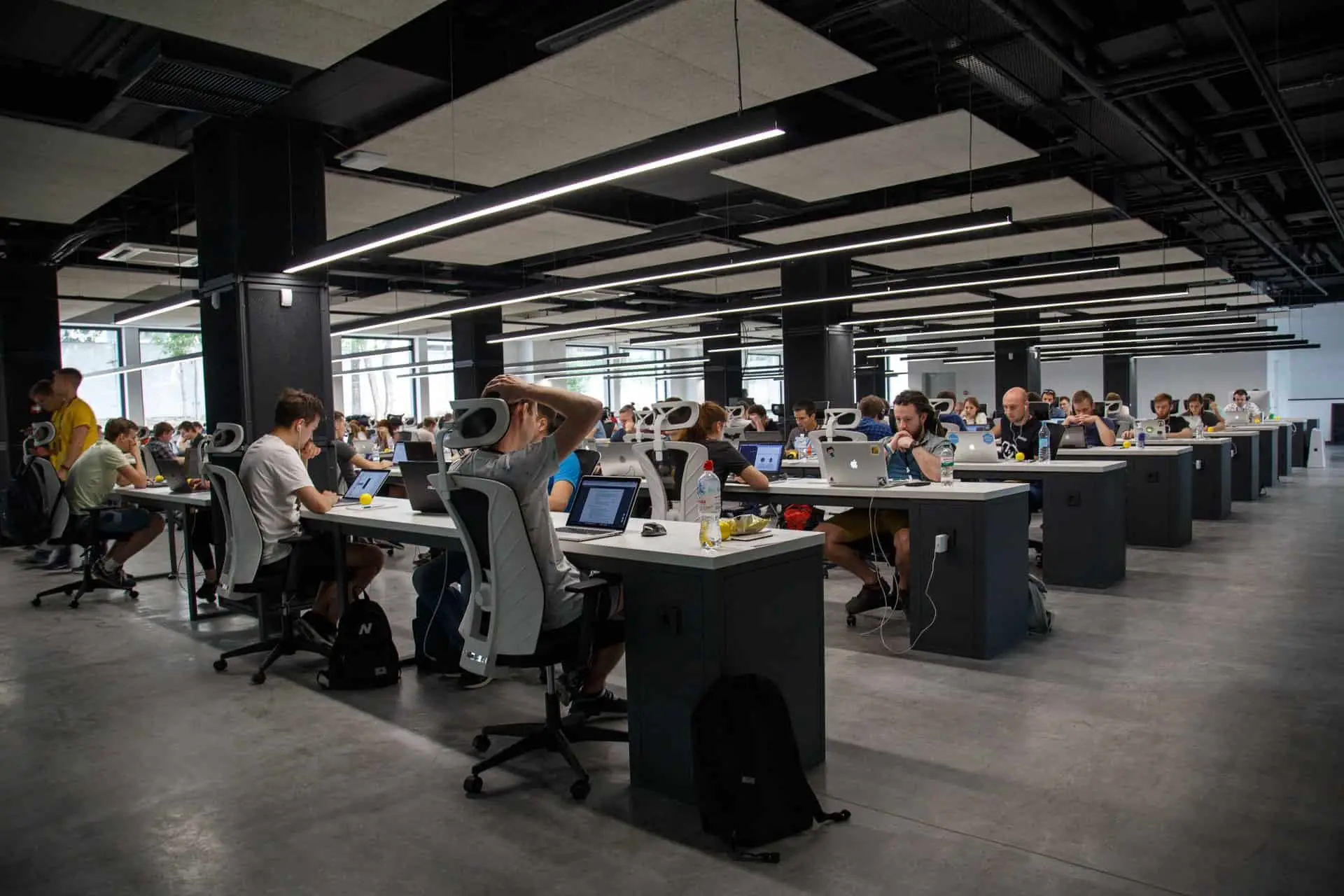Whether you are remodeling, expanding, or relocating into new office quarters, the number of challenges of creating an efficient design for your work area can eventually pile up. Naturally, what you would want to promote is a functional working environment that facilitates productivity, good collaboration, and innovation and, at the same time, keep your staff happy. One of the factors that inevitably affect these objectives, and thus require your full consideration, is the type of layout. Based on the sorts of tasks your employees perform, their need for face-to-face interaction with each other and clients, etc., you will need to figure out which one works best for your business. One such type of layout is an open-plan office space.
This concept completely discards partition walls and adopts the idea of visually pleasing quarters with rows of multi-person benches stretching as far as the eye can see and lounge areas meant for informal meetings and collaborations. Its appeals are recognized among many businesses, prompting entrepreneurs to hit the green light on the build. But what about the rest of them; why is this percentage hesitant? Before you either adopt or discard the idea of an open-plan office space, weighing out the pros and cons of the concept is a step you shouldn’t neglect.
Reasons why this concept deserves a thumbs up
Trading cubicles, barriers, and closed office doors for a feeling of community, employee integration, and better chances for the birth of many great ideas? That is the primary intention of those that went ahead with this project – this one, and many others.
– Camaraderie –
While camaraderie in the workplace may not seem essential at first glance, you may find that it is closely interconnected with many other benefits. Just think about how you would feel walking into your workspace each day and realizing that you will have to spend those notoriously long hours alongside people you don’t really know or like. For a large portion of people, it feels like a lot of stress, a low dose of energy and enthusiasm, and a desire to bolt out of that place as fast as they can. Consequently, the chances of productive and quality work are not at all high.
Happy personnel is productive personnel! It’s a well-known fact. So, some of the main advantages of open working environments are setting a path to a healthy, productive, and friendly professional atmosphere. How?
– By encouraging communication –
If your employees are not separated by some kind of a barrier, they are more likely to talk to each other. Increased communication is key to building interpersonal relationships, stronger professional bonds, and a decreased stress level among employees in their workplace.
in their workplace.
– By creating a relaxed environment –
What directly follows is friendly professional energy and atmosphere. Once you relocate into an open-concept office, you will see less secretiveness, boosting morale, but also a feeling of equity and unity. With employees situated close to each other, as well as the manager, you are breaking away from the past trends of pyramidical structure and hierarchy. This will give your business the reputation of favoring employee integration and their involvement in decision-making and projects.
– By promoting better collaboration –
In such an environment, you will see more teamwork and creative input, both of which are prospects for increased productivity, performance, and overall workflow. With isolating cubicles and people passing each other in the hallway from time to time, there’s no place for innovation and maximizing creative ideas. On the other hand, bringing them together helps faster learning, brainstorming for novel ideas, and then bringing those ideas to full potential at a quicker pace.

– Lower costs –
Another benefit of an open-plan office space is that of finances. Fewer construction costs, lower utility bills, and reduced office supply expenses can save the company a great deal of money in the long term. Firstly, setting up a certain number of cubicles is twice more costly than simply setting up an equal number of standing desks. Secondly, going for an open plan office space will also prove to be more efficient in terms of energy for electricity and air conditioning, so lower utility costs will again come with some savings for the company. Thirdly, as opposed to traditional offices, where each space usually has its own fax machine, printer, and stationery, opting for a non-traditional setup means that employees can share office equipment and resources and help the company cut costs.
will also prove to be more efficient in terms of energy for electricity and air conditioning, so lower utility costs will again come with some savings for the company. Thirdly, as opposed to traditional offices, where each space usually has its own fax machine, printer, and stationery, opting for a non-traditional setup means that employees can share office equipment and resources and help the company cut costs.
Lastly, you most probably plan on hiring commercial movers to assist you in this process of relocation and transfer all of the furniture and IT equipment to your office area. Moving companies typically charge by the hour as well as according to the number of obstacles that make it harder for them to carry your belongings from point A to point B (things such as lots of stairs, for example). With this in mind, it is obvious how fewer walls and barriers reduce the time and effort needed for transfer and setup.
of relocation and transfer all of the furniture and IT equipment to your office area. Moving companies typically charge by the hour as well as according to the number of obstacles that make it harder for them to carry your belongings from point A to point B (things such as lots of stairs, for example). With this in mind, it is obvious how fewer walls and barriers reduce the time and effort needed for transfer and setup.
– Space –
Another one of the appeals of open-plan offices recognized by many entrepreneurs is that of a great space in terms of:
• Aesthetics. When put up against a closed-plan office, an open-plan is the apparent winner in the field of aesthetics. When potential clients walk in, they will be able to see the core values of your business: the overall workforce progressing as a whole and friendly professional energy – instead of a bunch of dull and isolating cubicles and creative flow entrapped between two barriers.
• Functionality. You have all the freedom you need to adjust the layout easily, so it perfectly suits the needs of people working there. Try out some different modes of working, change the seating, and bring different teams to work together until you achieve the perfect match.
• Economy. This kind of concept enables you to accommodate more workspaces and provide more employees in the office area.
• Flexibility. Once you eliminate the walls separating different departments, reconfiguration, expansion, or downsizing is not an issue. You can adapt the place however you and your employees need.
• Creativity. Another pro is that it is a blank slate. Let’s face it – there’s not much you can do with those cubicles to make the place look less uniformed. Here, on the other hand, you have complete freedom in designing the place, experimenting with different types of furniture and color schemes to achieve a workplace that is pleasing to the eye and to which employees are happy to come to work.
– Easy management –
One centralized area makes things a lot easier for supervisors. There is no need to walk from office to office to keep tabs on each staff member, as you can easily see what everybody is doing. Secondly, this constant contact between managers and employees spurs faster problem solving as well as more efficient information flow.
to office to keep tabs on each staff member, as you can easily see what everybody is doing. Secondly, this constant contact between managers and employees spurs faster problem solving as well as more efficient information flow.
– Reasons why this concept deserves thumbs down –
Still, given that all companies, their employees, and their working methods and habits are different, opening things up is not for everyone. So, before you make your final decision, it helps to reflect on some drawbacks as well.
– Noise pollution –
The number one issue would probably be the noise. Co-workers talking amongst each other, taking their phone calls, etc.; such a lively atmosphere can get quite loud. It can be pretty tough to concentrate with all of the buzz going on around you, and once you tear down the walls, there will be nothing to contain it.
– Zero privacy –
Many employees argue against open workspaces because they feel a bit too exposed. And, truthfully, it isn’t easy obtaining some privacy in such conditions. An individual office makes it possible to answer confidential or family calls, whereas here, the same thing might lead workers to feel uncomfortable to answer.

– The chaotic feel –
Right next to noise and lack of privacy stands that hectic feeling you can’t shake off when you hear different conversations at once, see people walking to and fro, stretching, eating their meals, going through their drawers, their pencils falling off the table, etc. If one is used to solo-working or finds it hard to focus in general, anything at all is a potential distraction. In such conditions, building up your tolerance or finding ways to protect your focus can be challenging.
Naturally, you should definitely expect such chaos to occur and even intensify if you’re moving your office to a different location. Your employees’ commute to work will be different, so many of them might be late and show up to work at different times, causing distraction. Next, the furniture arrangement will most probably be different from before, again, generating some confusion. Workers will need some time to adapt to the new location and surroundings after the move. However, don’t let this affect your employees and their performance to an extent greater than usual, and find out how you can relocate with interruption as minimal as possible.
– Different sensitivities –
Lastly, just like each person has their own rhythm, needs, and habits, tastes and sensitivities vary as well, and one common area cannot be adjusted to suit everybody. Setting up the air conditioning, heating, and lighting to suit everybody’s taste is next to impossible in an open-plan office space.
Photos used:
1. https://unsplash.com/photos/QBpZGqEMsKg
2. https://pixabay.com/photos/workplace-team-business-meeting-1245776/
3. https://unsplash.com/photos/FSFfEQkd1sc

